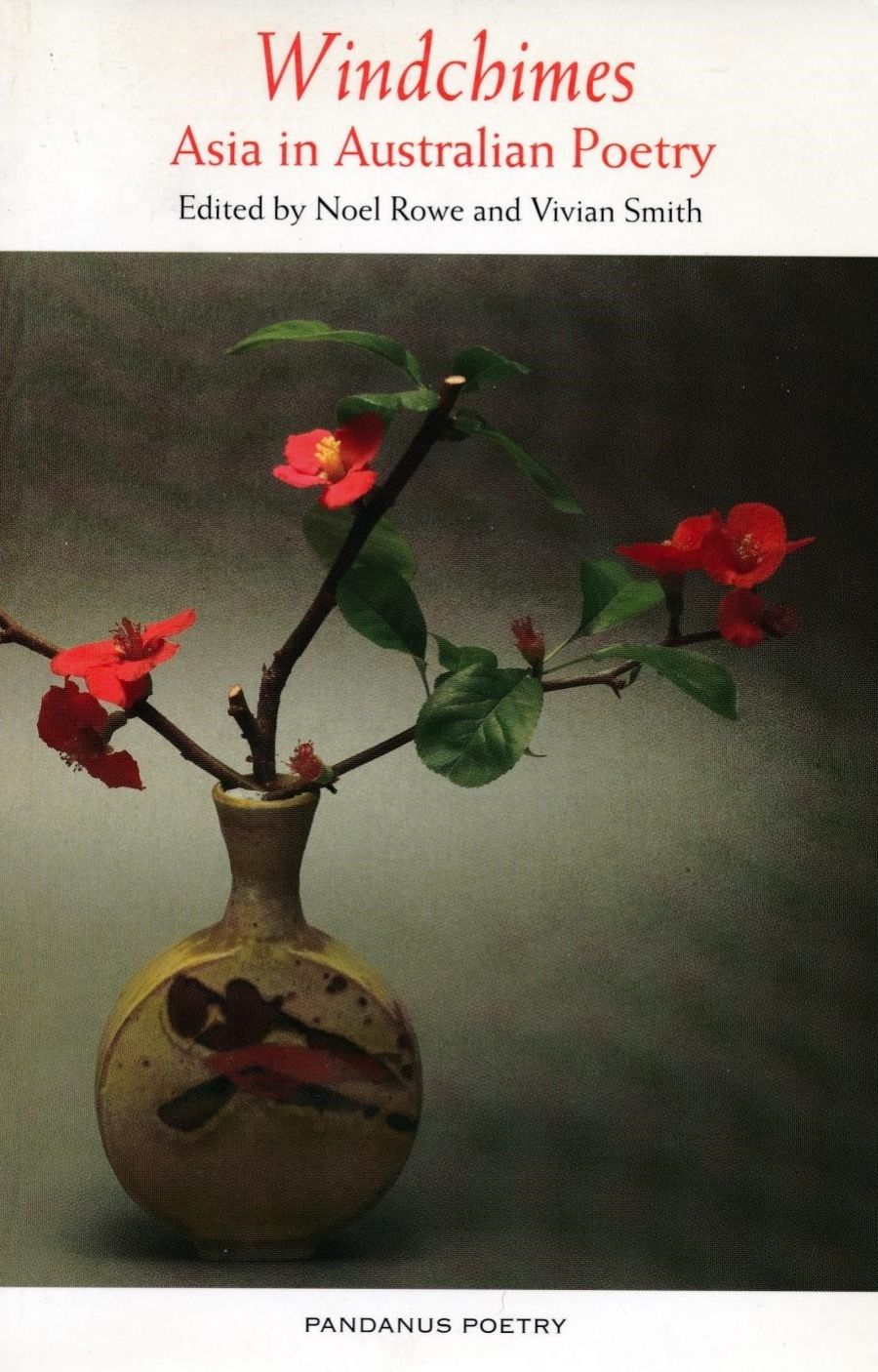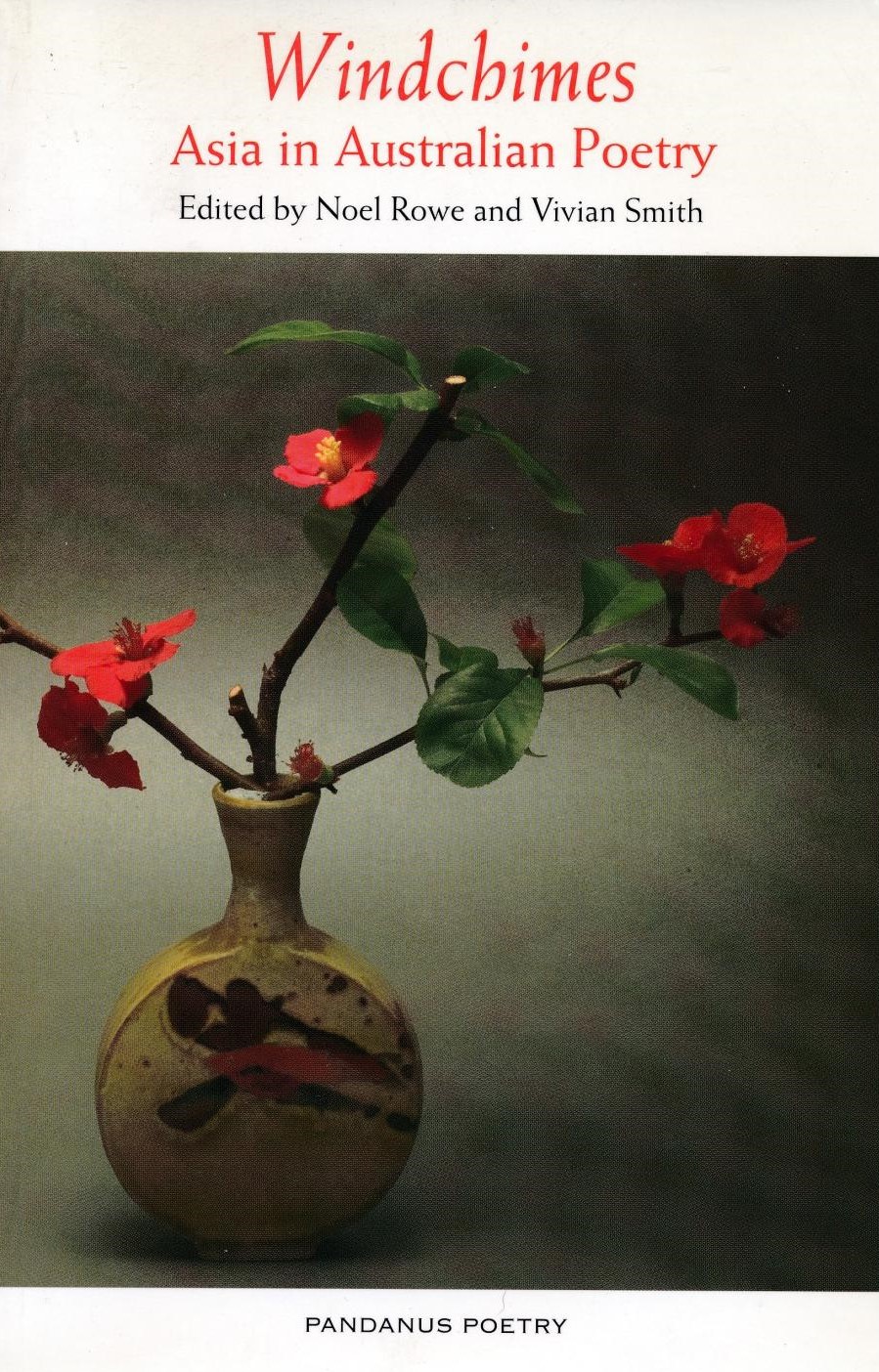
- Free Article: No
- Contents Category: Australian Poetry
- Review Article: Yes
- Article Title: Asia at home
- Online Only: No
- Custom Highlight Text:
All regions being regions of the mind, ‘Asia’ has had an especially unsettled and unsettling place in Australian thought. Australia has, in part, defined its own ‘occidental’ status with almost hysterical reference to its many ‘oriental’ neighbours. The putative border crisis of recent times, for instance, involved representing (mostly Middle Eastern and Asian) refugees as cashed-up ‘queue jumpers’ and potential terrorists who were ready to swamp our shores.
Asian ‘hordes’ have long been spectres haunting the Australian imagination. We see them in Windchimes, a marvellous anthology of ‘Asia in Australian Poetry’. But all of the usual suspects are present here, too: Asia as feminine and erotic; as terminally superstitious or spiritually enlightened; as a realm of pure aestheticism; as timeless or primitive; and as a region of war and warriors. All of these tropes, like the idea of ‘Asia’ itself (a region that supposedly ranges from China to Turkey), are as factitious as the notion that Asia is even a distinct continent. So far, so Edward Said, whose Orientalism (1978) made such observations postcolonial clichés. But if we consider the poetry of Australia as it reflects upon the idea of Asia, then we find an exciting literature that both maps and exceeds such tropes.
- Book 1 Title: Windchimes
- Book 1 Subtitle: Asia in Australian Poetry
- Book 1 Biblio: Pandanus, $29.95 pb, 277 pp
- Book 1 Cover Small (400 x 600):

- Book 1 Cover (800 x 1200):

Asian ‘hordes’ have long been spectres haunting the Australian imagination. We see them in Windchimes, a marvellous anthology of ‘Asia in Australian Poetry’. But all of the usual suspects are present here, too: Asia as feminine and erotic; as terminally superstitious or spiritually enlightened; as a realm of pure aestheticism; as timeless or primitive; and as a region of war and warriors. All of these tropes, like the idea of ‘Asia’ itself (a region that supposedly ranges from China to Turkey), are as factitious as the notion that Asia is even a distinct continent. So far, so Edward Said, whose Orientalism (1978) made such observations postcolonial clichés. But if we consider the poetry of Australia as it reflects upon the idea of Asia, then we find an exciting literature that both maps and exceeds such tropes.
The idea of an anthology of ‘Asia in Australian Poetry’ is so pertinent that it is surprising no one has produced one before now. But the wait was certainly worthwhile. The editors of Windchimes, Noel Rowe and Vivian Smith, have produced a superb publication. Their selection not only traces the history of Australian imagining of Asia (which is partly a history of Australian racism) but also illustrates how identity has been conceptualised – sometimes crudely, sometimes artfully – by contact with Asian countries and cultures. It also shows, as Rowe and Smith write in their lucid and informative introduction, that ‘[t]he story of Australian poetry’s conversation with Asia becomes much more complex and interesting as soon as poets start to adopt and adapt Asian literary forms’.
Rowe and Smith are themselves important poets. The poetry of each is notable for its attention to form, clarity and the resonant image. Such an aesthetic might seem apposite with regard to their anthology. The ‘Asian’ in poetry is usually thought of in terms of the short, resonant image in the contained structure of a traditional form, the most well known of which is, of course, the haiku. There are plenty of haiku in Windchimes. One of the best is from that great satirist, Laurie Duggan:
a paper butterfly
sails over the windowsill
– my Australia Council cheque!
This shows an admirable lack of preciousness on the part of the editors. They know the dangers of too much cherry blossom and rain.
As Rowe and Smith observe in their introduction, Asia was figured in Australian poetry in passing throughout the nineteenth century, but it only properly becomes thematic at the beginning of the twentieth. This is no surprise, given that the White Australia Policy was a product of the twentieth century. (Indeed, the first piece of legislation passed by the federal government was the Immigration Restriction Act 1901).
As is common to racist cultures, early twentieth-century Australia found the Asian Other both erotically alluring and socially disturbing. Such dyadic thinking often played itself out (and continues to play itself out) in terms of aesthetics and politics. Such duality is seen especially in the early poems in the book. Henry Lawson writes in ‘The Tracks That Lie by India’ that ‘The misty ways of Asia are calling unto me’, while in ‘To Be Amused’ he writes prophetically that ‘I see the brown and yellow rule / The southern lands and southern waves’. As the latter poem shows, many of the early poems in Windchimes are horribly racist in their representations of Asians and Asia. Indeed, for those who lament the loss of poetry as a form of public speech, it is worth noting that these poems (most of which appeared in the Bulletin, whose motto until 1961 was ‘Australia for the White Man’) show that the quality of poetic public speech is never simply a given. Poems such as Brunton Stephens’s popular ‘My Chinee Cook’ and ‘My Other Chinee Cook’ are characteristic in presenting the Chinese as laughable, untrustworthy and criminal.
The early part of the book, as the editors implicitly acknowledge, is largely of historical interest. As a collection of poetry, the anthology really takes off about a quarter of the way in, with Kenneth Slessor (though Mary Gilmore’s ‘Fourteen Men’ is a powerful denunciation of racism). Slessor’s poems remind us that modernism (most obviously via the Imagists) was partly a form of orientalism.
The editors have eschewed, for the most part, extracts from longer work (which unfortunately means that the ‘Asian’ sections of Alan Wearne’s two-volume The Lovemakers [2001–04] are not represented). They break their own rule occasionally, however, such as for Harold Stewart’s epic-sized By the Old Walls of Kyoto (1981), the heroic couplets of which strike me as strangely inapposite: ‘Hours later, in the huge and sultry gloom / A temple bell has tolled with solemn boom.’ Such lines remind me of the couplets in my old Rupert annuals (which, coincidentally, were also fascinated with the oriental).
There are scores of very fine poems in Windchimes, as well many classics, such as David Campbell’s indictment of the Vietnam War, ‘My Lai’, and selections from Rosemary Dobson’s ‘The Continuance of Poetry’. In Dobson’s work we see the apotheosis of an Asian aesthetic that is neither parodic nor culturally spurious: ‘Could you join me once more? / Out walking now I see blond grass, / Wild orchids, black cattle, and the daylight moon.’ Dobson’s revision of classical poets such as Li Po and Wang Wei is contemporary, precise and tough. Similar qualities can be found in the poems collected here by Jennifer Strauss, Chris Wallace-Crabbe, Fay Zwicky, and Robert Gray. The epigrammatic and comic potential of verse forms such as the senryu and the pantoum can be found in poems by Geoffrey Lehmann and Peter Porter (whose ‘The Pantoum of the Opera’ offers one of the book’s most memorable puns).
If the middle of the anthology is dominated by war and tourism, the latter part is dominated by themes of identity, in particular the belated appearance of the ‘Asian-Australian’, firmly undermining the binary terms of Australian and Asian. Shen’s ‘Geography’ and ‘Noodles’, which end the anthology, deal with the opposing forces of new and old in ways that are indubitably ironic. Ouyang Yu’s ‘The Ungrateful Immigrant’, meanwhile, undoes any sentimental notions of cross-cultural identity with its satire and its biting humour.
Recent poems, such as those by Kathryn Lomer, M.T.C. Cronin, Michael Brennan, Greg McLaren, and Judith Beveridge (to name a handful), show that the idea of Asia continues to appeal to poets, especially through the informed interpolation of Buddhist beliefs and poetics. Asia remains an idea that continues to attract divergent responses. Contemporary poets, however, illustrate a more self-conscious understanding of Asian places, cultures and histories than their early twentieth-century counterparts.
It is a great shame that the publisher of Windchimes, Pandanus, has recently ceased to exist (at least in print form). Pandanus and the editors have produced a marvellous anthology. (My one quibble is to wonder why the editors chose to exclude India from their brief.) As well as the informative introduction, the work is well designed, and has useful notes on poetic forms, biographical information on the authors, and indispensable notes on the poems. The care, scale, and attention to detail are all seen in one of the work’s most impressive poems, Stephen Edgar’s astonishing ‘Silk Screen’. Neither short nor set in Asia, Edgar’s poem is a tour-de-force description of Hobart figured as if it were a landscape scroll. ‘The sun cannot resist / Showing the flag of imperial Japan / (Except translucent, moted with the mist).’ Edgar’s work, and that of his contemporaries, shows how much we can gain through intercultural experience, even when we stay at home.


Comments powered by CComment